This is named after William Wygston, several times the mayor of Leicester and a benefactor to the city. The rents from his estate in Wigston supported the hospital which he built, where Leicester Grammar School now stands. Wigston Magna gets its name from ‘Viking’s Tun’ or ‘settlement’. The Old English word ‘viking’ means ‘pirate’.
An illustration of William Wygston.
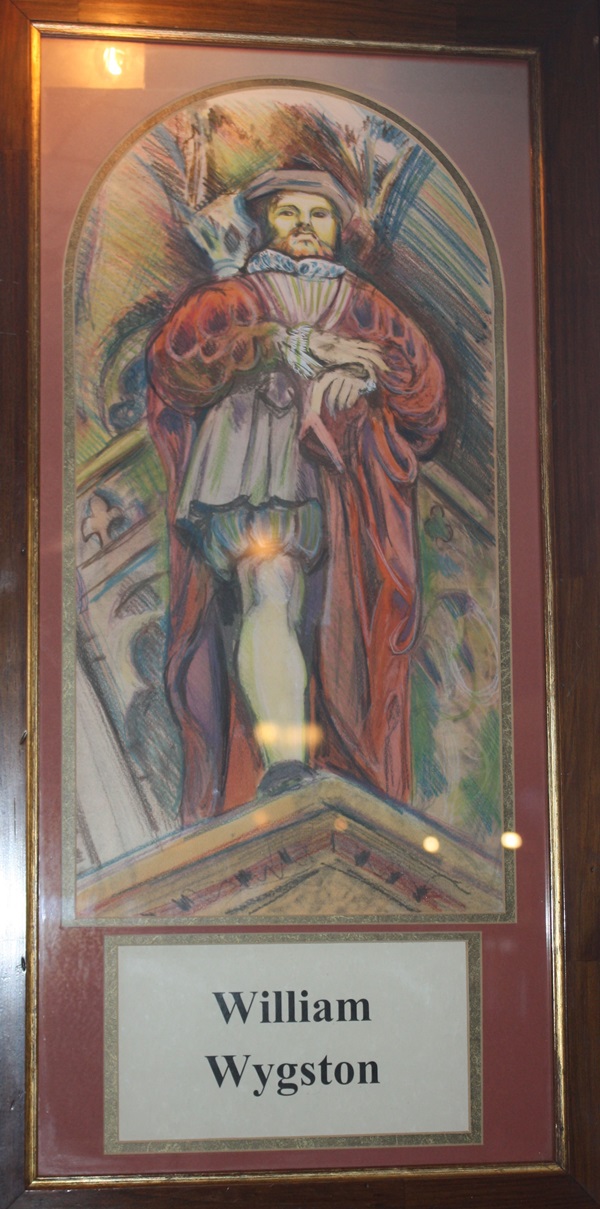
An illustration and text about Roger and William Wygston.
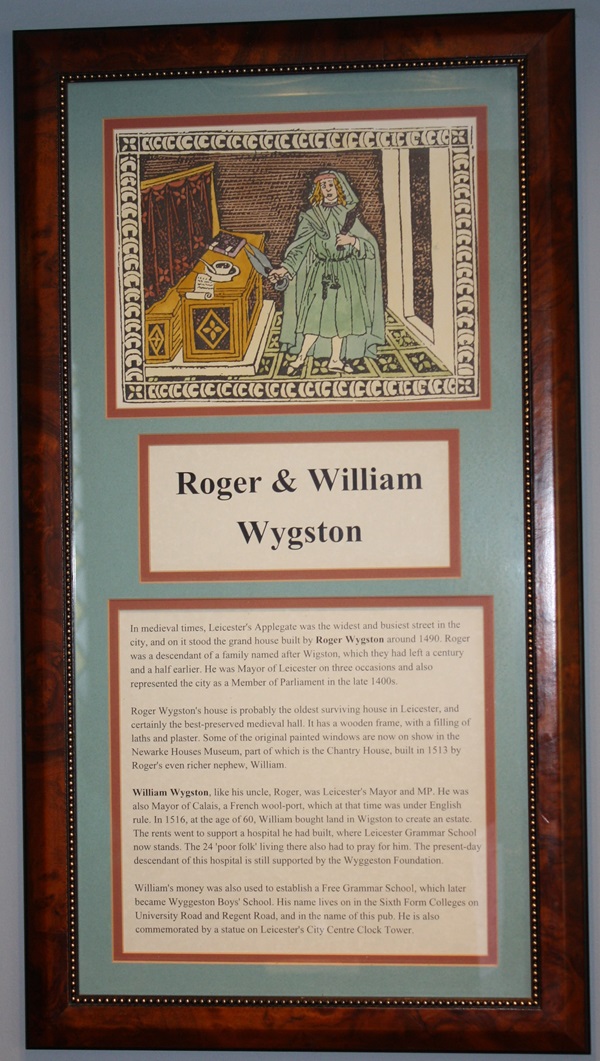
The text reads: In medieval times, Leicester’s Applegate was the widest and busiest street in the city, and on it stood the grand house built by Roger Wygston around 1490. Roger was a descendant of a family named after Wigston, which they had left a century and a half earlier. He was Mayor of Leicester on three occasions and also represented the city as a Member of Parliament in the late 1400s.
Roger Wygston’s house is probably the oldest surviving house in Leicester, and certainly the best-preserved medieval hall. It has a wooden frame, with a filling of laths and plaster. Some of the original painted windows are now on show in the Newarke Houses Museum, part of which is the Chantry House, built in 1513 by Roger’s even richer nephew, William.
William Wygston, like his uncle, Roger, was Leicester’s Mayor and MP. He was also Mayor of Calais, a French wool-port, which at the time was under English rule. In 1516, at the age of 60, William bought land in Wigston to create an estate. The rents went to support a hospital he had built, where Leicester Grammar School now stands. The 24 ‘poor folk’ living there also had to pray for him. The present-day descendant of this hospital is still supported by the Wyggeston Foundation.
William’s money was also used to establish a Free Grammar School, which later became Wyggeston Boys’ School. His name lives on in the Sixth Form Colleges on University Road and Regents Road, and in the name of this pub. He is also commemorated by a statue on Leicester’s City Centre Clock Tower.
Text about William Wygston.
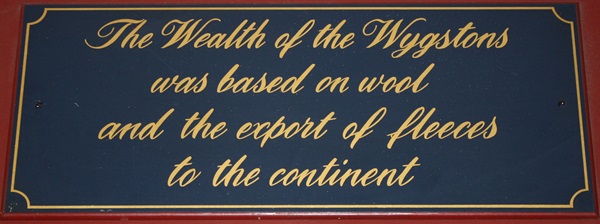
The wealth of the Wygston’s was based on wool and the export of fleeces to the continent.

William Wygston’s hospital survives to this day and is still supported by his foundation.

William endowed a Free Grammar School, later Wyggeston Boys School, and built the Charity House now a part of Newarke Houses Museum.

Wygston’s house, probably the oldest in Leicester, still stands in Applegate. It was built around 1490.

Roger Wygston, three times Mayor of Leicester and M.P. under Kings Edwards IV & Henry VII.
Prints and text about Henry Davis Pochin.
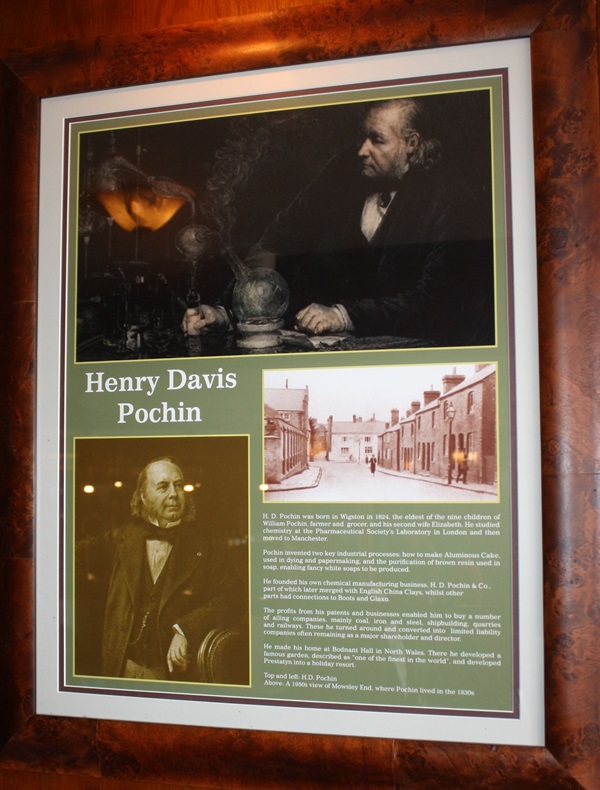
The text reads: H.D. Pochin was born in Wigston in 1824, the eldest of the nine children of William Pochin, farmer and grocer, and his second wife Elizabeth. He studied chemistry at the Pharmaceutical Society’s Laboratory in London and then moved to Manchester.
Pochin invented two key industrial processes; how to make Aluminous Cake, used in dying and papermaking, and the purification of brown resin used in soap, enabling fancy white soaps to be produced.
He founded his own chemical manufacturing business, H.D. Pochin & Co., part of which later merged with English China Clays, whilst other parts had connections to Boots and Glaxo.
The profits from his parents and businesses enabled him to buy a number of ailing companies, mainly coal, iron and steel, shipbuilding, quarries and railways. These he turned around and converted into limited liability companies often remaining as a major shareholder and director.
He made his home in Bodnant Hall in North Wales. There he developed a famous garden, described as 2one of the finest in the world2, and developed Prestatyn into a holiday resort.
Top and left: H.D Pochin
Above: A 1950’s view of Mowsley End, where Pochin lived in the 1830s.
Text about Gertie Gitana.
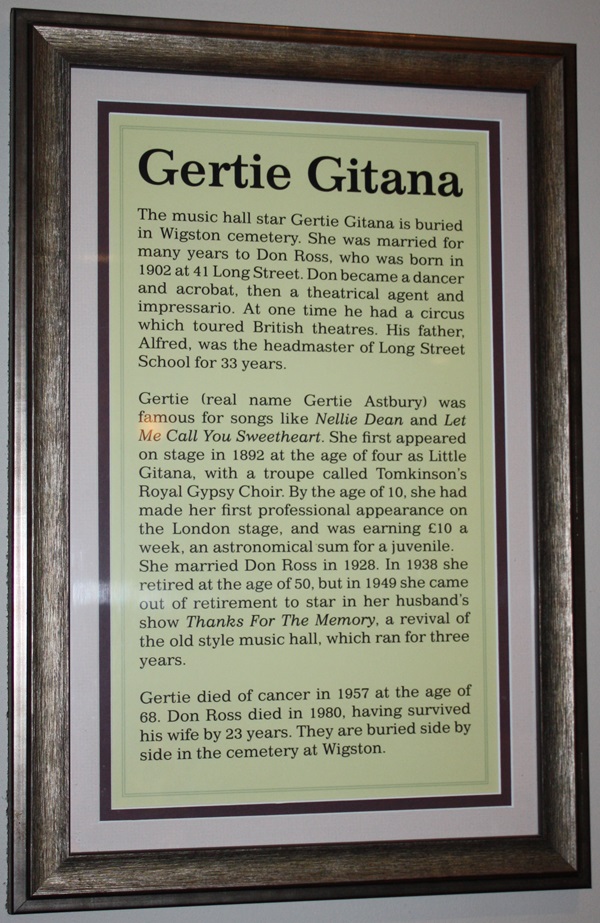
The text reads: The music hall star Gertie Gitana is buried in Wigston cemetery. She was married for many years to Don Ross, who was born in 1902 at 41 Long Street. Don became a dancer and acrobat, then a theatrical agent and impresario. At one time he had a circus which toured British theatres. His father, Alfred, was the headmaster of Long Street School for 33 years.
Gertie (real name Gertie Astbury) was famous for songs like Nellie Dean and Let Me Call You Sweetheart. She first appeared on stage in 1892 at the age of four as a Little Gitana, with a troupe called Tomkinson’s Royal Gypsy Choir. By the age of 10, she had made her first professional appearance on the London stage, and was earning £10 a week, an astronomical sum for a juvenile. She married Don Ross in 1928. In 1938 she retired at the age of 50, but in 1949 she came out of retirement to star in her husband’s show Thanks For the Memory, a revival of the old style music hall, which ran for three years.
Gertie died of cancer in 1957 at the age of 68. Don Ross died in 1980, having survived his wife by 23 years. They are buried side by side in the cemetery at Wigston.
Photographs and prints and Gertie Gitana.
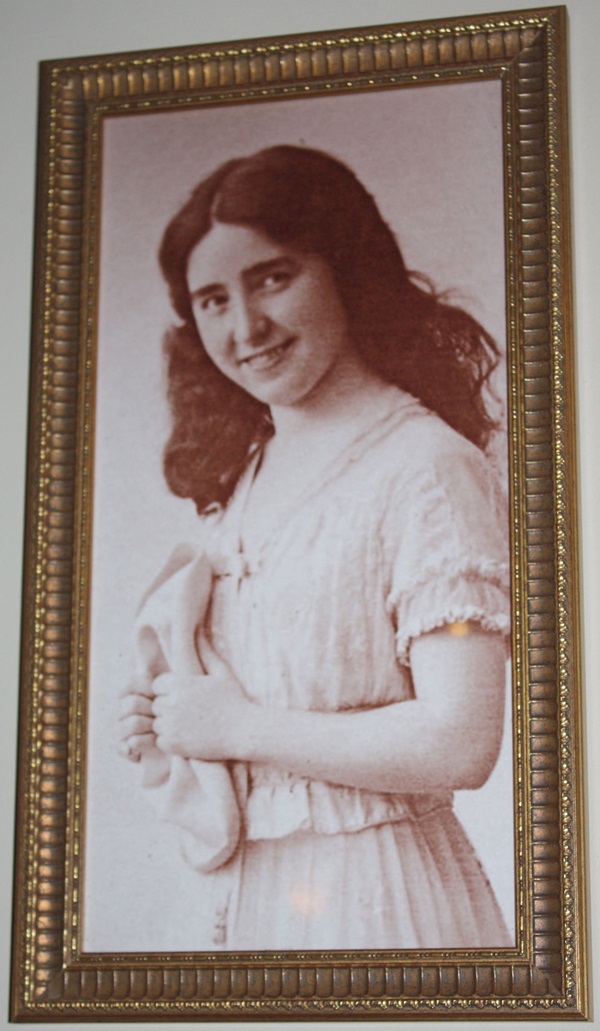
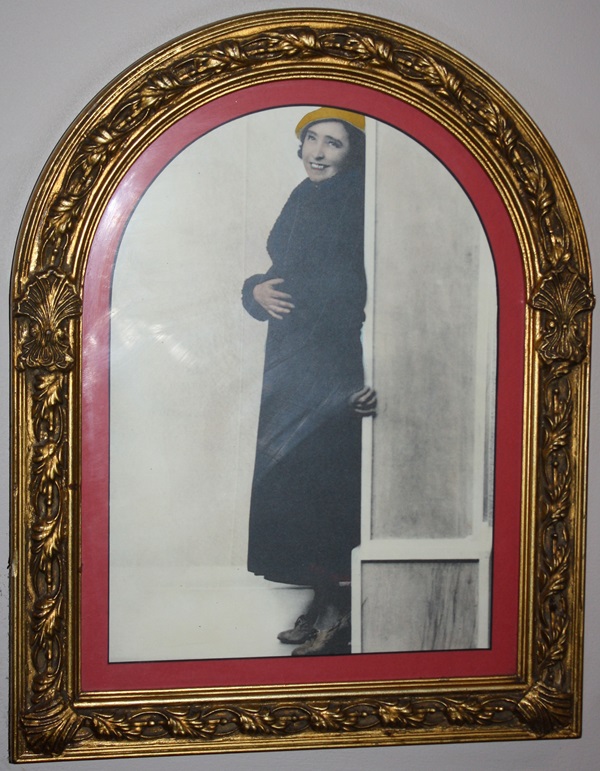
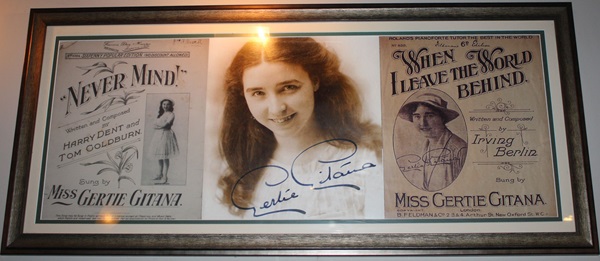
Text about cinemas in the area.
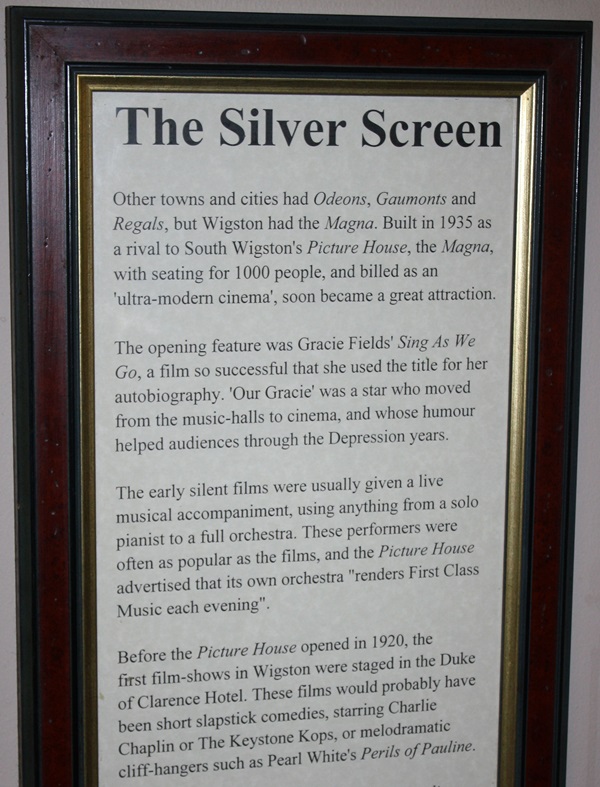
The text reads: Other towns and cities had Odeons, Gaumonts and Regals, but Wigston had the Magna. Built in 1935 as a rival to South Wigston’s Picture House, the Magna, with seating for 1000 people, and billed as an ‘ultra-modern cinema’, soon became a great attraction.
The opening feature was Gracie Fields’ Sing As We Go, a film so successful that she used the title for her autobiography. ‘Our Gracie’ was a star who moved from the music-halls to cinema, and whose humour helped audiences through the Depression years.
The early silent films were usually anything from a solo pianist to a full orchestra. The performers were often as popular as the films and the Picture House advertised that its own orchestra “renders First Class Music each evening”.
Before the Picture House opened in 1920, the first film-shows in Wigston were staged in the Duke of Clarence Hotel. These films would probably have been short slapstick comedies, starring Charlie Chaplin or The Keystone Kops, or melodramatic cliff-hangers such as Pearl White’s Perils of Pauline.
Prints and text about Jonathan Swift’s mother.

The text reads: Jonathan Swift was born in 1667 in Dublin, but his mother, Abigail Herrick, was from Wigston. The famous author of Gulliver’s Travels was Abigail’s second child and only son. His father was an attorney at King’s Inn, Dublin. Who died seven months before his son was born.
Abigail had a family connection with the poet Robert Herrick. His father’s family had several interesting literary connections. His grandmother was the niece of Sir Erasmus Dryden, grandfather of the poet John Dryden. The same grandmother’s aunt was related to the wife of Sir Walter Raleigh. His great- great grandmother was the sister of Francis Godwin, author of The Man in the Moone, which influenced parts of Gulliver’s Travels. His uncle, Thomas Swift, married a daughter of the poet playwright Sir William Davenant, a godson of William Shakespeare.
The death of her husband left Abigail with no income, so she returned to this area to live with relatives. Jonathan was here for a while, before he went back to Dublin to live with his wealthy paternal uncle Godwin Swift.
The political unrest surrounding the Glorious Revolution of 1688, and the loss of financial support from his Uncle, forced him to return to his mother in Leicester. Abigail helped him to obtain a position as Secretary to retired diplomat Sir William Temple. This move dramatically changed his life. He soon became acquainted with many politically influential figures of the day and his career took off.
Above: Jonathan Swift, c.1733
Far right: Sir William Temple
Right: Swift in 1743 Top right: Gulliver – a 70’ fiberglass model on Dollymount Strand, near Dublin, a beach where Swift often rode his horse.
A print, illustration and text about churches and railways in Wigston.
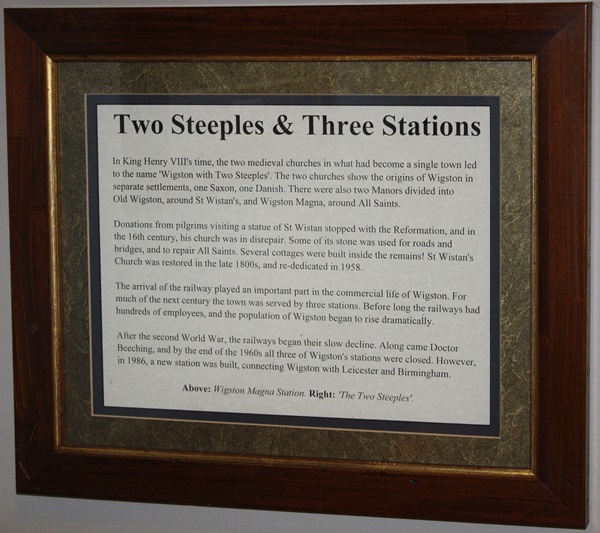
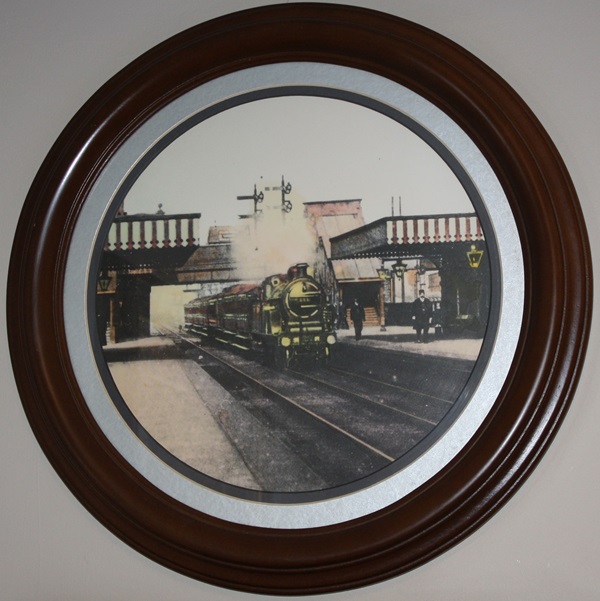
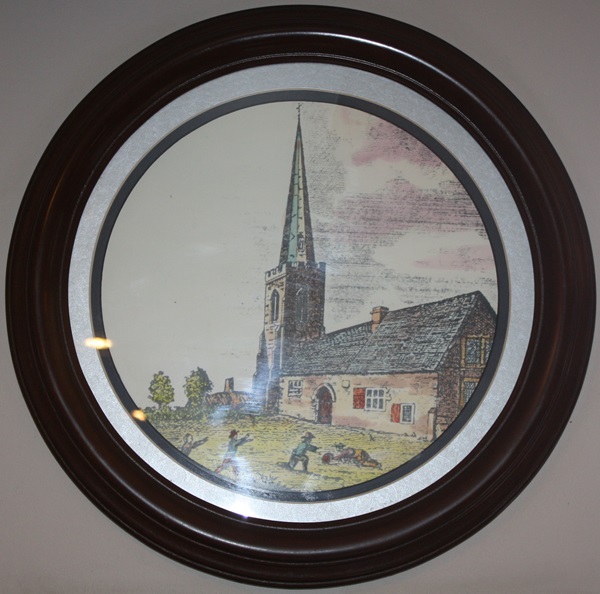
The text reads: In King Henry VIII’s time, the two medieval churches in what had become a single town led to the name ‘Wigston with Two Steeples’. The two churches show the origins of Wigston in separate settlements, one Saxon, one Danish. There were also two Manors divided into Old Wigston, around St Wistan’s and Wigston Magna, around All Saints.
Donations from the pilgrims visiting a statue of St Wistan stopped with the Reformation, and in the 16th century, his church was in desrepair. Some of its stone was used for the roads and bridges, and to repair All Saints. Several cottages were built inside the remains! St Wistan’s Church was restored in the late 1800s, and re-dedicated in 1958.
The arrival of the railway played an important part in the commercial life of Wigston. For much of the next century the town was served by three stations. Before long the railways has hundreds of employees, and the population of Wigston began to rise dramatically.
After the second World War, the railways began their slow decline. Along came Doctor Beeching, and by the end of 1960s all three of Wigston’s stations were closed. However in 1986, a new station was built, connecting Wigston with Leicester and Birmingham.
Above: Wigston Magna Station
Right: ‘The Two Steeples’.
Photographs and text about Bushloe House and Christopher Dresser.
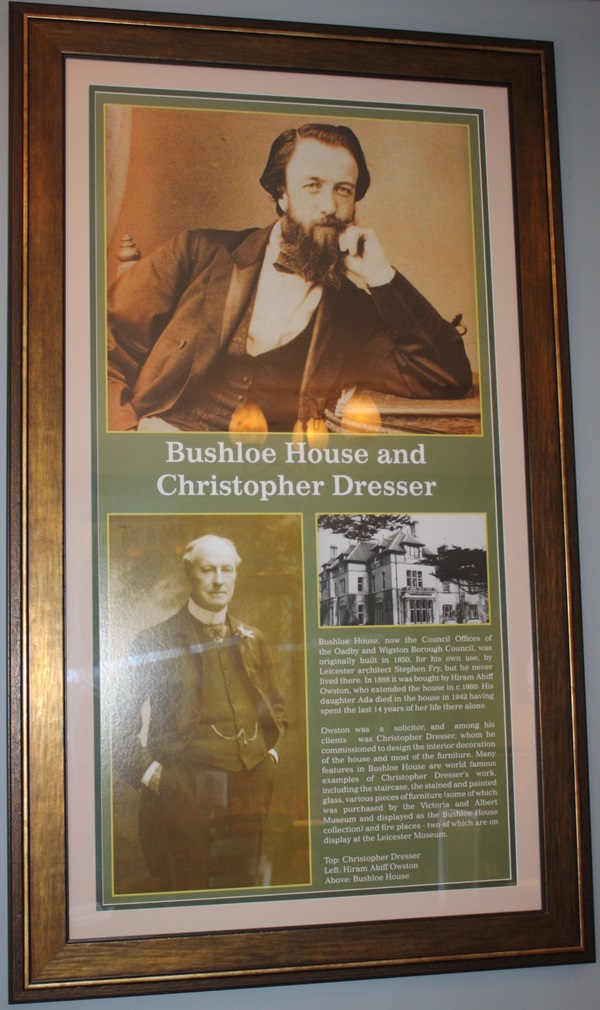
The text reads: Bushloe House, now the Council Offices of the Oadby and Wigston Borough Council, was originally built in 1850, for his own use, by Leicester architect Stephen Fry, but he never lived there. In 1866 it was bought by Hiram Abiff Owston, who extended the house in c.1880 having spent the last 14 years of her life there alone.
Owston was a solicitor and among his clients was Christopher Dresser, whom he commissioned to design the interior decoration of the house and most of the furniture. Many features in the Bushloe House are world famous examples of Christopher Dresser’s work, including the staircase, the stained and painted glass, various pieces of furniture (some of which was purchased by the Victoria and Albert Museum and displayed as the Bushloe House collection) and fire places – two of which are on display at the Leicester Museum.
Top: Christopher Dresser
Left: Hiram Abiff Owston
Above: Bushloe House.
Photographs and text about Graham Chapman.
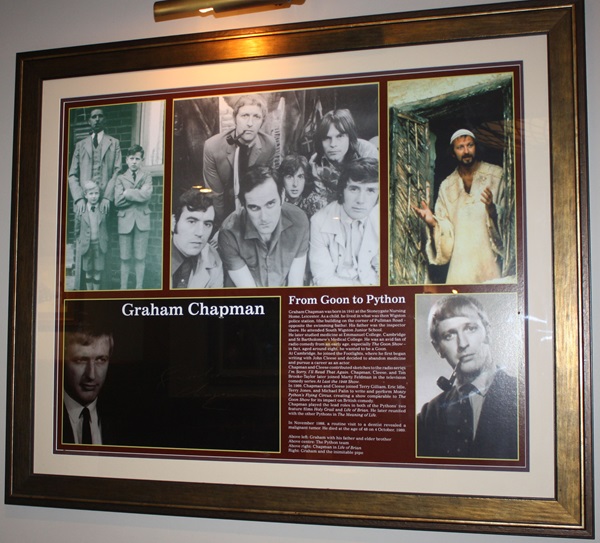
The text reads: Graham Chapman was born in 1941 at the Stoneygate Nursing Home, Leicester. As a child, he lived in what was then Wigston police station, (the building on the corner of Pullman Road – opposite the swimming baths). His father was the inspector there. He attended South Wigston Junior School.
He later studied medicine at Emmanuel College, Cambridge and St Bartholomew’s Medical College. He was an avid fan of radio comedy from an early age, especially The Goon Show – in fact, aged around eight, he wanted to be a Goon.
At Cambridge, he joined the Footlights, where he first began writing with John Cleese and decided to abandon medicine and pursue a career as an actor.
Chapman and Cleese contributed sketches to the radio series I’m Sorry, I’ll Read That Again. Chapman, Cleese, and Tim Brooke-Taylor later joined Marty Feldman in the television comedy series At Last the 1948 Show.
In 1969, Chapman and Cleese joined Terry Gilliam. Eric Idle, Terry Jones, and Michael Palin to write and perform Monty Pyston’s Flying Circus, creating a show comparable to The Goon Show for its impact of British comedy.
Chapman played the lead roles in both of the Pythons’ two feature films Holy Grail and Life of Brian. He later reunited with the other Pythons in The Meaning of Life.
In November 1988, a routine visit to a dentist revealed a malignant tumour. He died at the age of 48 on 4 October, 1989.
Above left: Graham with his father and elder brother
Above centre: The Python team
Above right: Chapman in Life of Brain
Right: Graham and the inimitable pipe.
Prints and text about school days in Wigston.
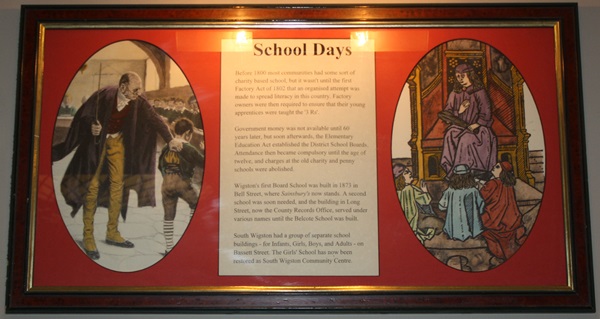
The text reads: Before 1800 most communities has some sort of charity based school, but it wasn’t until the first Factory Act of 1802 that an organised attempt was made to spread literacy in this country. Factory owners were then required to ensure that their young apprentices were taught the ‘3 Rs’.
Government money was not available until 60 years later, but soon afterwards, the Elementary Education Act established the District School Boards. Attendance then became compulsory until the age of twelve, and charges at the old charity and penny schools were abolished.
Wigston’s first Board School was built in 1873 in Bell Street, where Sainsbury’s now stands. A second school was soon needed, and the building in Long Street, now County Records Office, served under various names until the Belcote School was built.
South Wigston had a group of separate school building – for infants, Girls, Boys, and Adults – on Bassett Street. The Girls’ School has now been restored as South Wigston Community Centre.
An illustration of the village school.
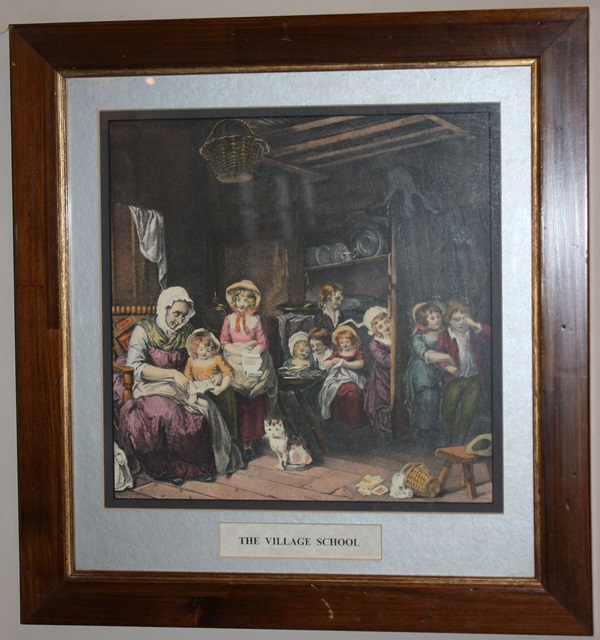
A print of the state school.
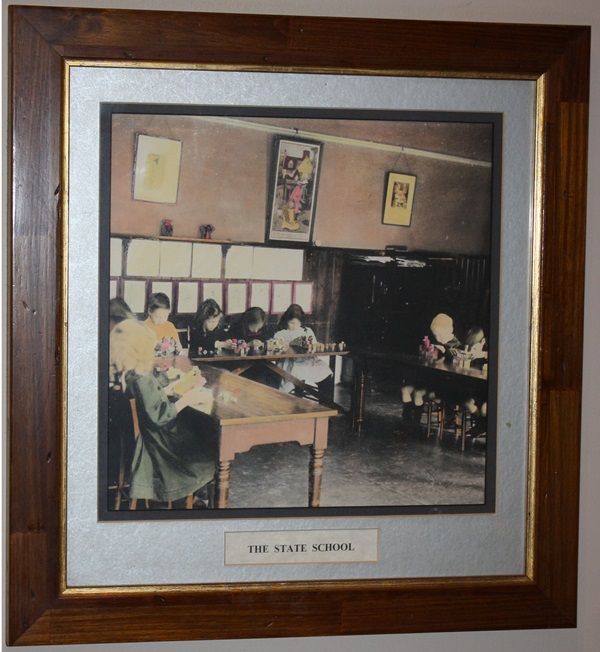
A photograph of a Motor Fire Engine, c.1912.
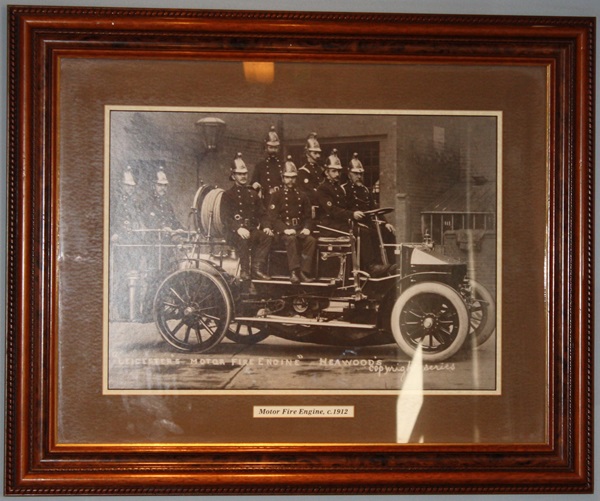
A photograph of old Wigston, c.1910.
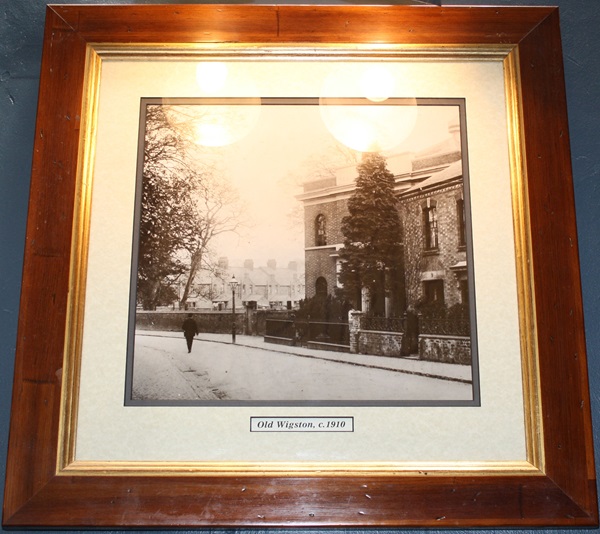
A photograph of Memorial Park, Wigston, c.1930.
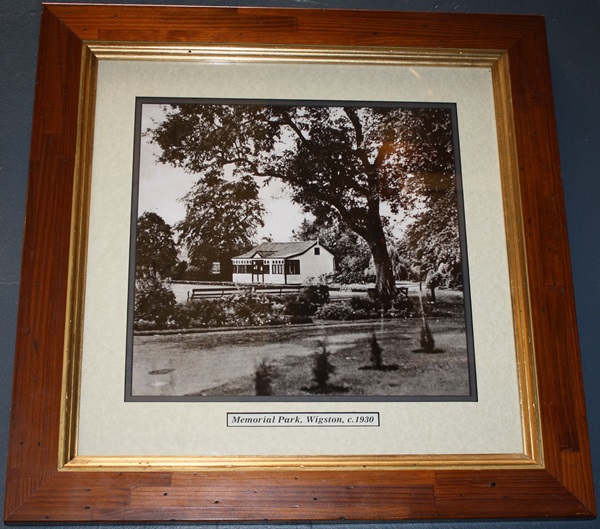
A photograph of St Wolstans Church, Wigston, c.1908.
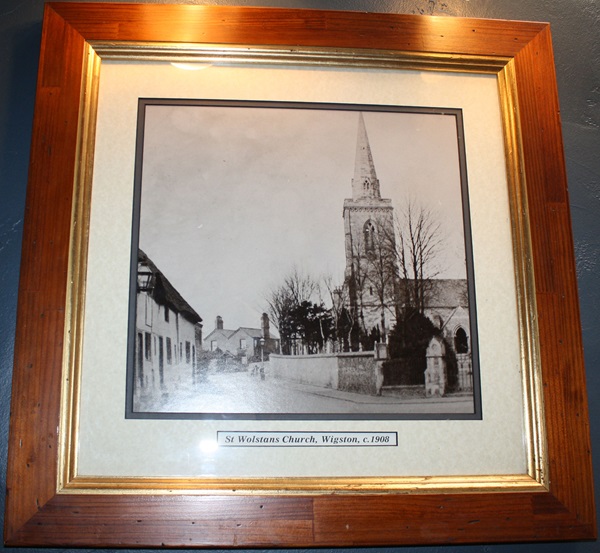
A photograph of Blaby Road, South Wigston, c.1908.
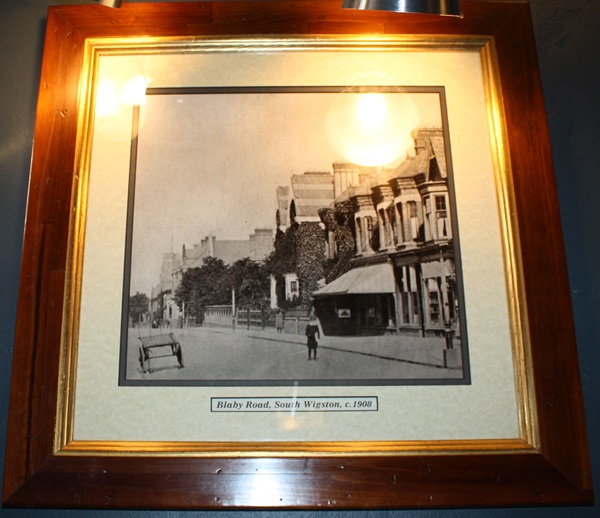
A metal dragon sculpture on display in the pub.
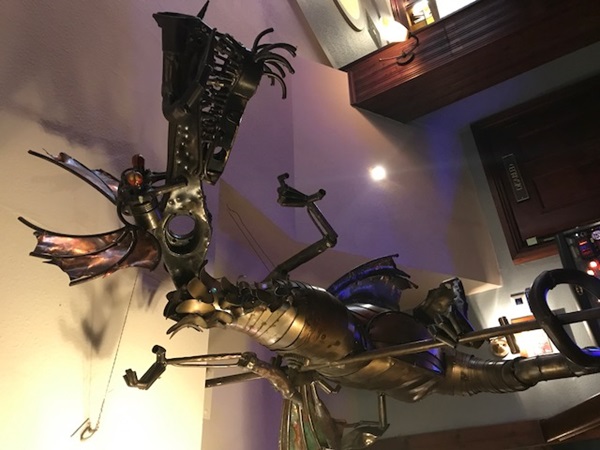
External photograph of the building – main entrance.
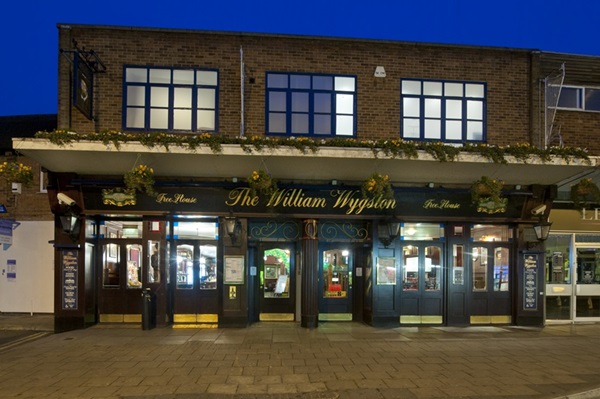
If you have information on the history of this pub, then we’d like you to share it with us. Please e-mail all information to: pubhistories@jdwetherspoon.co.uk